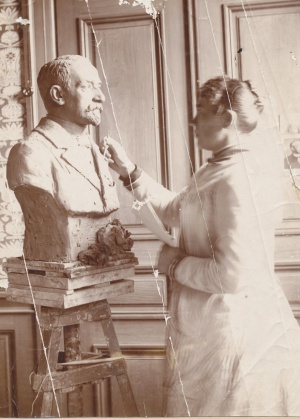Nielsine Petersen facts for kids
Nielsine Petersen was a talented Danish sculptor. She was born on July 10, 1851, and lived until November 26, 1916. She is remembered for her beautiful sculptures, especially her bronze statue of Hamlet and a charming piece called En dreng, der fisker krabber (A boy fishing for crabs).
The Life of Nielsine Petersen
Nielsine Caroline Petersen was born in a place called Nyrup, on the island of Zealand in Denmark. Her parents were Mads Petersen and Kirstine Madsen.
When she was older, Nielsine moved to Copenhagen. She went to a drawing school run by Vilhelm Kyhn. After that, she became a student of a famous sculptor named August Saabye. This helped her learn how to create amazing sculptures.
Early Achievements
Nielsine showed her artwork for the first time at a big art show called the Charlottenborg Spring Exhibition in 1880. This was a very important step for her career. In 1883, she won a special award called the Neuhausen Prize.
Later, in 1889, she received a travel scholarship from the Academy. This allowed her to study art in Paris, France. Paris was a major center for art at that time, and this trip helped her grow even more as an artist.
Royal Recognition and Famous Works
Nielsine continued to win awards for her sculptures. In 1893, she won the Eibeschütz Prize for her statue named Ismail. In 1908, she was given the Ingenio et arti medal, which is a very high honor in Denmark for artists and scientists.
In 1901, something very exciting happened. King Edward VII and Queen Alexandra of Denmark invited her to visit Buckingham Palace in London for eleven days! She also received several awards from other countries. These included the French Ordre des Palmes académiques, a Russian Medal of Merit, and the British Order of Merit for Art and Science.
Nielsine Petersen is especially remembered for two of her sculptures. One is a bronze statue of Hamlet, a famous character from a play. The other is En dreng, der fisker krabber (A boy fishing for crabs), which she made in 1884.
Nielsine first had her art studio on Bredgade in Copenhagen. Later, she moved her studio to a villa in Hellerup. She passed away in 1916 and was buried at Hellerup Cemetery.


